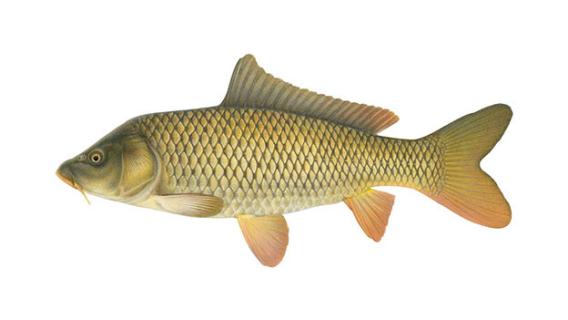Know Your Fish
Fishing in Colorado means opportunity and chance to catch some 35 species of both warm- and cold-water fish. You can fish for the famed rainbow trout in a cool Rocky Mountain stream or troll for walleye on a sunny plains reservoir. And Colorado offers everything in between, too.

Navigate to:
Fish in Colorado
Plan Your Fishing Trip
Filter by:
Invasive Species

Brown Trout
This species is not fishable.
Brown Trout are golden-brown to olive on their back and sides; with large dark spots on their sides, dorsal fin and sometimes upper lobe of their tail. Red spots with light halos dispersed along their side.
Physical Characteristics:
Commonly Found:
Gear Required:
Bait:
Threats to species:
Invasive Species

Channel Catfish
This species is not fishable.
Channel Catfish are gray to silver on their back and sides, with black spots on their side. Large fish lack spots and appear dark olive or slate. White belly. Forked Tail. Long barbels around their mouth. Adipose fin (fleshy dorsal fin).
Physical Characteristics:
Commonly Found:
Gear Required:
Bait:
Threats to species:
Invasive Species

Chinook Salmon
This species is not fishable.
Currently, there are no known Chinook Salmon occurrences in Colorado.
Chinook are the largest of the Pacific salmon species. They are distinguished from the other species by having a black lower gum line and mouth, spots on both lobes of the tail, and many spots on the back, but few on the fins.
Physical Characteristics:
Commonly Found:
Gear Required:
Bait:
Threats to species:
Invasive Species

Colorado Pikeminnow
This species is not fishable.
The Colorado pikeminnow is the largest minnow in North America and is an endangered, native fish of the Colorado River thought to have evolved more than 3 million years ago. Called the “white salmon” by early settlers due to its migratory behavior, the Colorado pikeminnow has a torpedo-shaped body and a large, toothless mouth. It has an olive-green and gold back and a silvery-white belly.
Physical Characteristics:
Commonly Found:
Gear Required:
Bait:
Threats to species:
Invasive Species

Colorado River Cutthroat Trout
This species is not fishable.
Colorado River cutthroat trout have a bright yellow-gold body with a brassy-green back and orange belly, medium to large spots concentrated on the caudal peduncle and dorsal region (though spotting varies by region) and absent on the pectoral, pelvic, and anal fins, and 180-200 lateral line scales.
Physical Characteristics:
Commonly Found:
Gear Required:
Bait:
Threats to species:
Invasive Species

Common Carp
This species is not fishable.
Common Carp have two pairs of barbels near their mouth. Brassy yellow to golden brown or dark-olive sides, with white belly. Some red on their tail and anal fin. Dark spot at the base of each scale.
Physical Characteristics:
Commonly Found:
Gear Required:
Bait:
Threats to species:
Invasive Species

Cutbow
This species is not fishable.
The Cutbow is a mix between a Rainbow Trout and a Cutthroat Trout.
Physical Characteristics:
Commonly Found:
Gear Required:
Bait:
Threats to species:
Invasive Species

Flathead Catfish
This species is not fishable.
Flathead catfish are a large, robust catfish species with a broad head that is somewhat compressed (hence the name). They are generally brown in overall coloration, with darker mottling over the entire body. They have a huge mouth in which the lower jaw's tip extends past that of the upper jaw. The upper lobe of the square tail is lighter in coloration than the rest.
Physical Characteristics:
Commonly Found:
Gear Required:
Bait:
Threats to species:
Invasive Species

Freshwater Drum
This species is not fishable.
Freshwater drum or sheephead are a deep-bodied fish with a head that slopes quickly upward from the rounded and subterminal snout. They possess both spiny and soft-rayed dorsal fins, with the soft-dorsal being elongated. Each of the pelvic fins has a single spine, and the anal fin possesses two spines. They also have a strongly upturned lateral line and a rounded to pointed tail fin.
Physical Characteristics:
Commonly Found:
Gear Required:
Bait:
Threats to species:
Invasive Species

Golden Trout
This species is not fishable.
Golden Trout are brown to olive in color on their backs. Golden yellowish sides, with crimson stripe and dark markings along a lateral line. Red gill covers. Adipose fin (fleshy dorsal fin). Triangular dorsal fin.
Physical Characteristics:
Commonly Found:
Gear Required:
Bait:
Threats to species:
Researching Colorado Waters

Aquatic Research
The Colorado Parks and Wildlife Aquatic Research Section provides a combination of field and laboratory experimentation to answer statewide fisheries management questions and manages aquatic species.

Aquatic Health Lab
The Aquatic Animal Health Laboratory provides in-house support and diagnostic services, including Bacteriology, Molecular testing, Whirling disease testing, Virology and Parasitology.

Aquatic Toxicology Lab
The Aquatic Toxicology Lab conducts experiments that help inform decision makers and managers about pollution and water quality risks.

Hatcheries
CPW operates 19 fish hatcheries, where over 90 million fish per year are bred, hatched, reared and stocked. This includes over 30 different species of fish as well as the boreal toad.